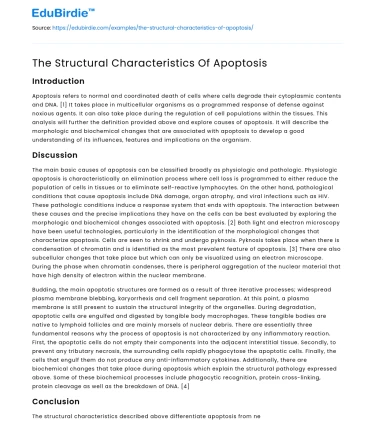Introduction
Apoptosis refers to normal and coordinated death of cells where cells degrade their cytoplasmic contents and DNA. [1] It takes place in multicellular organisms as a programmed response of defense against noxious agents. It can also take place during the regulation of cell populations within the tissues. This analysis will further the definition provided above and explore causes of apoptosis. It will describe the morphologic and biochemical changes that are associated with apoptosis to develop a good understanding of its influences, features and implications on the organism.
Discussion
The main basic causes of apoptosis can be classified broadly as physiologic and pathologic. Physiologic apoptosis is characteristically an elimination process where cell loss is programmed to either reduce the population of cells in tissues or to eliminate self-reactive lymphocytes. On the other hand, pathological conditions that cause apoptosis include DNA damage, organ atrophy, and viral infections such as HIV. These pathologic conditions induce a response system that ends with apoptosis. The interaction between these causes and the precise implications they have on the cells can be best evaluated by exploring the morphologic and biochemical changes associated with apoptosis. [2] Both light and electron microscopy have been useful technologies, particularly in the identification of the morphological changes that characterize apoptosis. Cells are seen to shrink and undergo pyknosis. Pyknosis takes place when there is condensation of chromatin and is identified as the most prevalent feature of apoptosis. [3] There are also subcellular changes that take place but which can only be visualized using an electron microscope. During the phase when chromatin condenses, there is peripheral aggregation of the nuclear material that have high density of electron within the nuclear membrane.
Budding, the main apoptotic structures are formed as a result of three iterative processes; widespread plasma membrane blebbing, karyorrhexis and cell fragment separation. At this point, a plasma membrane is still present to sustain the structural integrity of the organelles. During degradation, apoptotic cells are engulfed and digested by tangible body macrophages. These tangible bodies are native to lymphoid follicles and are mainly morsels of nuclear debris. There are essentially three fundamental reasons why the process of apoptosis is not characterized by any inflammatory reaction. First, the apoptotic cells do not empty their components into the adjacent interstitial tissue. Secondly, to prevent any tributary necrosis, the surrounding cells rapidly phagocytose the apoptotic cells. Finally, the cells that engulf them do not produce any anti-inflammatory cytokines. Additionally, there are biochemical changes that take place during apoptosis which explain the structural pathology expressed above. Some of these biochemical processes include phagocytic recognition, protein cross-linking, protein cleavage as well as the breakdown of DNA. [4]
Conclusion
The structural characteristics described above differentiate apoptosis from necrosis. The three reasons discussed above essentially provide the reasoning behind apoptosis as a process that is not toxic. On the contrary, necrosis, is a toxic process given that it is characterized by degradative processes that take place after the death of the cell. The complex nature of molecular processes that take place during apoptosis have been a hindrance in creating an understanding of the mechanisms behind the process.
References
- Green DR. Apoptosis: physiology and pathology. Cambridge University Press; 2011 Aug 22.
- Sluyser M, editor. Apoptosis in normal development and cancer. CRC Press; 2002 Sep 11.
- Melino G, Vaux D, editors. Cell death. John Wiley & Sons; 2010 Feb 22.
- Lavin M, Watters D. Programmed cell death. CRC Press; 1993 Dec 8.






 Stuck on your essay?
Stuck on your essay?

